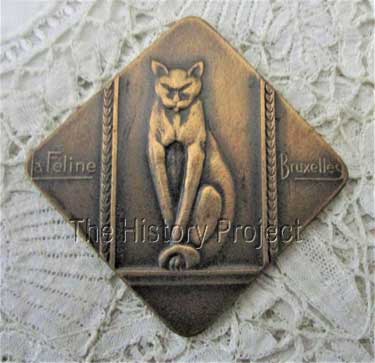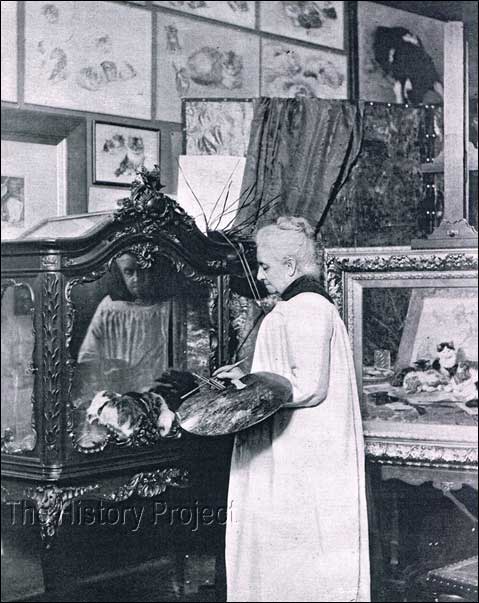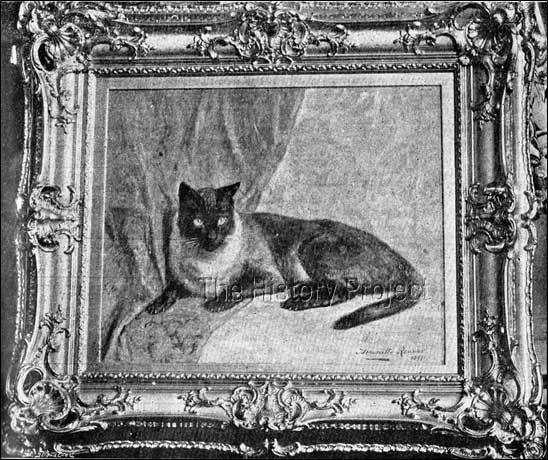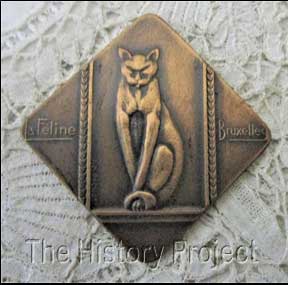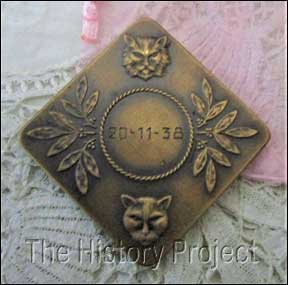 | ||||||||||||||||||||||||||||||||||||









|
1938, La Feline Bruxelles Bronze Medal
Historical BackgroundOver the years, medallions and other show awards, have followed the pre-eminent artistic stylisation of their respective era, and this is also particularly noticeable in all classes of feline related jewellery. This piece, although dated 1938, is stylistically reminiscent of the late Art Nouveaux period. However, long before Cat Exhibiting was popularised in Brussels, some Belgian communities appear to have enjoyed partaking in another rare form of feline activity, that of 'cat racing', rather akin to their already very well publicised, highly popular, and successful 'pigeon racing'. Cat Racing in BelgiumThanks to Harrison Weir, we can cite the following record published in his epic work, Our Cats, in 1889; of a curious social sporting phenomenon that took place in Belgium in the 19th century. In this, he quotes directly from an article found in the Pictorial Times, which dates from June 16th, 1860: "On festival days, parties of young men assemble in various places to shoot with cross-bows and muskets, and prizes of considerable value are often distributed to the winners. Then there are pigeon-clubs and canary-clubs, for granting rewards to the trainers of the fleetest carrier- pigeons and the best warbling canaries. Of these clubs many individuals of high rank are the honorary presidents, and even royal princes deign to present them banners, without which no Belgian club can lay claim to any degree of importance. "But the most curious thing is cat-racing, which takes place, according to an engraving, in the public thoroughfare, the cats being turned loose at a given time. It is thus inscribed: "Cat- racing is a sport which stands high in popular favour. In one of the suburbs of Liege, it is an affair of annual observance during the carnival time. Numerous individuals of the feline tribe are collected, each having round his neck a collar with a seal attached to it, precisely like those of the carrier-pigeons. The cats are tied up in sacks, and as soon as the clock strikes the solemn hour of midnight the sacks are unfastened, the cats let loose, and the race begins. The winner is the cat which first reaches home, and the prize awarded to its owner is sometimes a ham, sometimes a silver spoon. On the occasion of the last competition, the prize was won by a blind cat." Although Weir alludes to an engraving, no image is provided in his book; but the below illustration of this event was published on at least two occasions in the English press, this version dating from 1879, coincidentally appearing in The Pictorial World.
The Early Cat Fancy in BrusselsThe cat fancy was active in Brussels from the late 19th century, with the premier Exhibition of the Cat Club of Brussels taking place in 1891. An original full-page print, featuring an etching of some of the beautiful exhibits from that show is held in The Harrison Weir Collection, and is shown below.
Brussels was also the home of Madame Henriette Ronner-Knip, the famous painter of cats and dogs, who was coincidentally, an Honorary Vice-President of the National Cat Club, during the mid-1890's. The newly appointed President of the National Cat Club during that period, was Mary, Duchess of Bedford, avid and active fancier of both Siamese and Persian type cats, both of which she kept on the Ducal estate at Woburn Abbey. In fact, the Duchess took her aging Siamese male 'Goblin' on a journey to Brussels in 1899 to be painted by Henriette Ronner. The result, was a masterful rendering in oils of one of the most iconic Siamese cats of that era. A photograph of the painting appeared on the cover page of 'Our Cats' published November 10th, 1900. The painting, in the same ornate gilt frame, fortunately survives to this day, and is part of the late Duchess' estate, and is on occasion still exhibited in her private apartments.
ConclusionBrussels, and indeed all of Belgium, continues to take an active part in the modern cat fancy. Its clubs regularly hold cat shows that attract exhibits from all corners of Europe. In the twentieth century, many fine examples of Belgian Silver and Bronze feline medallions were produced, and these remain highly collectable items to this day.
References
|
|||||||||||||||||||||||||||||||||||
Home | Cats | Gallery | Clubs | People | Artifacts | Articles | Updates | Contact Us ©The CFA Foundation, Inc and The Harrison Weir Collection
|
||||||||||||||||||||||||||||||||||||
